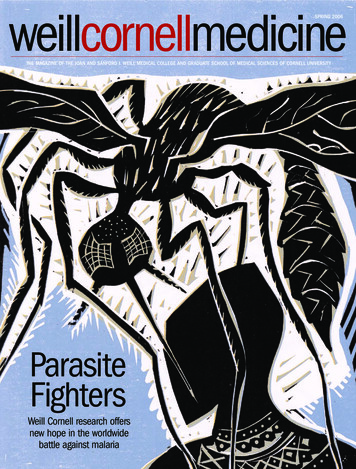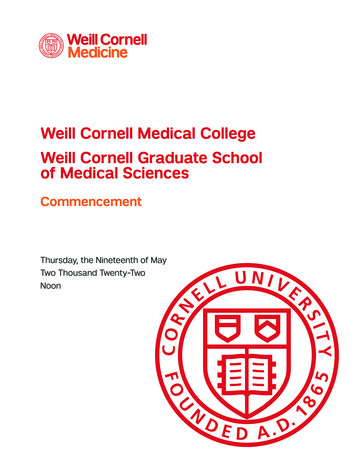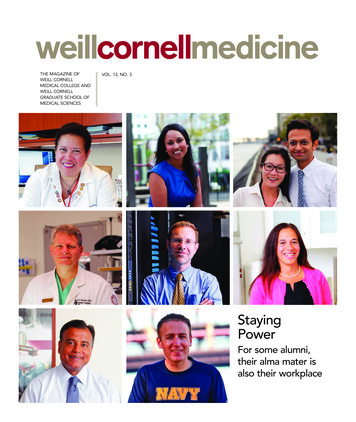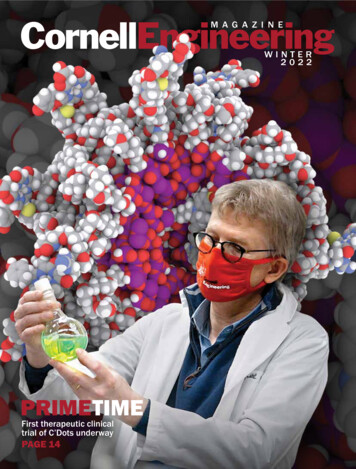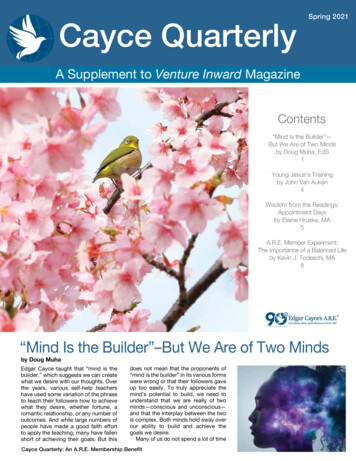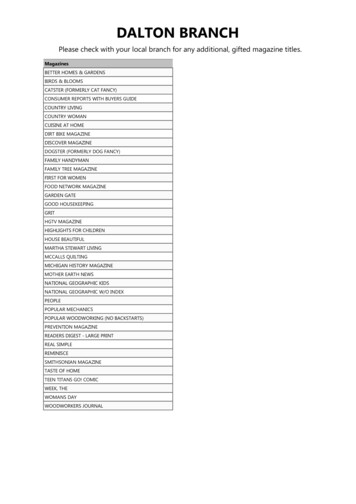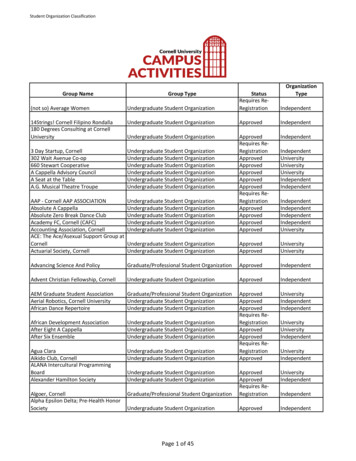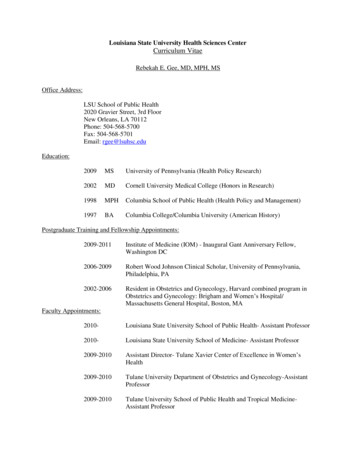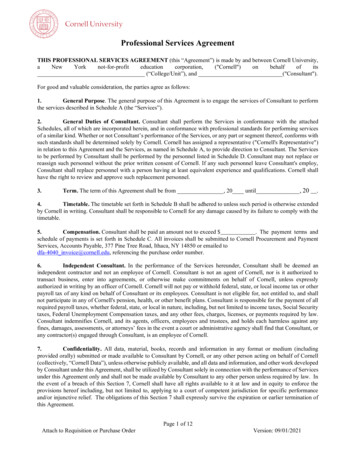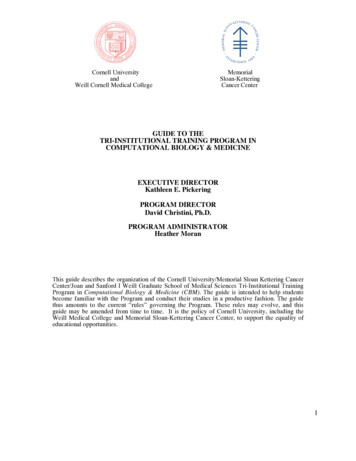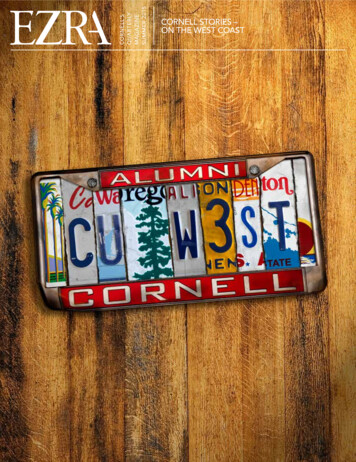
Transcription
CORNELL’SQUARTERLYMAGAZINESPRING 2015SPECIALSESQUICENTENNIALISSUE
picture cornell
CORNELL’S QUARTERLY MAGAZINEfeatures0612CORNELL IN 2065: ‘WHAT I SEE HAPPENING’We asked faculty, staff and students what Cornell, and theirfields, might be like when the university turns 200Timeline: Key moments from Cornell’s first 150 years28CHARTER DAY WEEKEND30CORNELL AT 150April 24-27 will be an on-campus and around-the-globecelebration of Cornell’s beginningPicture Cornell: Celebrating the sesquicentennial aroundthe world323334Looking into the crystal ball: The 1960 predictions of PresidentMalott, who looked 40 years ahead at a future Cornell36Cornell celebrates 150: President David Skorton andPresident-elect Elizabeth Garrett look to the futureSweet Cornell: Official ice cream of the sesquicentennialThe future campus: Walkable, sustainable, shaped byfounder’s visiondepartments04 CORNELL UNIVERSE44 PICTURE CORNELL 50M Verizon gift for Cornell Tech executiveed center, “Jennie’s Will” staged on campusand Cornell’s first-ever giving day.“The Big Idea! Cornell Celebrates 150”has been staged in NYC and aroundthe world40 CORNELL HISTORY46 LET’S GO BIG REDEzra’s virtual time capsuleSome of Big Red Athletics’ topmoments of all time42 CAMPAIGN NEWSFinding and funding a room of one’s ownUniversity surpasses its 5.75 billioncampaign goalStudents strike a pose during the 2014Mechanical and Aerospace Engineering PaperAirplane Competition.48 WE CORNELLIANS“We Cornellians”: Quirks, prideand tradition4349 END NOTEYou Can Make It Happen: Creative waysto make a difference through givingWalking across a bridge to the futureBy Lizzie Klein ’18Spring 2015 ezramagazine.cornell.edu 1
from the publisherEZRA: Cornell’s quarterly magazineVol. VII, Issue 3, Spring 2015Publisher: Tracy Vosburgh, Associate Vice Presidentfor University Communications, University RelationsManaging Editor: Joe Wilensky, UniversityCommunications, University RelationsSenior Editor: Emily Sanders Hopkins, AlumniAffairs and DevelopmentEzra Editorial Board:Jennifer Campbell, Director of Communications,Alumni Affairs and DevelopmentKaren Walters, Senior Director for News,University Communications, University RelationsShane Trost, Senior Director for Marketing,University Communications, University RelationsLead Designer and Project Manager:Christopher J. KellyPhotography: Robert Barker, Matthew Fondeur,Lindsay France, Jason KoskiContributors: Daniel Aloi, Jose Beduya, FranklinCrawford, Shannon Dortch, Blaine Friedlander, GwenGlazer, Jeremy Hartigan, Emily Sanders Hopkins,Anne Ju, Kate Klein, Lizzie Klein, Krishna Ramanujan,Roger Segelken, Mike Webb, Joe WilenskyProduced by the Cornell Chronicle, AAD Communications and University Communications Marketing.Diversity and inclusion are a part of CornellUniversity’s heritage. We are a recognized employerand educator valuing AA/EEO, protected veterans,and individuals with disabilities.Here we are: After so many months of preparationand planning by so many Cornellians, we arecelebrating our sesquicentennial, with Charter DayWeekend (April 24-27) right around the corner.Our 150th year has been an exciting one with somany changes, both big and small. I came to Cornellin 2006, just as we announced that David Skortonwould become the university’s next president. Today, as we look back athis legacy and appreciate his near-decade of leadership, we also can lookforward and see exciting times ahead as we get ready to welcome ElizabethGarrett as our 13th president.This year has also been a year of change for Ezra magazine. This is one ofthose seemingly small changes – but to me, it has been a very importantchange. The magazine was relaunched with a thematic approach and has,for the past several issues, explored big topics in a deeper way than waspossible in the past. We integrated our creative and editorial teams to tellour stories in a more interconnected and impactful way. Our covers becamebolder, with the goal of creating provocative images that make you want tolook inside. The interior layout is contemporary and more accessible. Eachimage is carefully considered and selected to tell a story and give the readera better experience.This has been a fun year, and we have more changes to come. I thank thethousands (yes, thousands!) of you who sent us feedback when we asked.I was pleased with how positive your comments were, and I look forwardto continuing to share the story of Cornell in new and different ways as wemove into our 151st year.Subscription information:ezramagazine@cornell.eduor call 607-255-3630.ezramagazine.cornell.eduPrinted using soy inks on Flo paper(FSC- and SFI-certified, 10% PCW,and manufactured using 100%Green-e certified energy).FSC RECYCLINGINFO HERE03/15 28.2M Cohber Design 2014 67ON THE COVER:Design by Clive Howard and Christopher J. Kelly ofUniversity Communications, University Relations2Tracy VosburghAssociate Vice President, University CommunicationsUniversity Relations
The warm tones of the ceiling in SageChapel glow in the afternoon sun.Spring 2015 ezramagazine.cornell.edu 3
KilographCORNELL UNIVERSE4 50M Verizon giftnames Cornell Tech executive ed center“Cornell Tech is a place for technology innovators andA 50 million gift from Verizon to Cornell Tech willleaders in New York City and around the world, andsupport the Verizon Executive Education Center,we are thrilled that Verizon is joining with us to createCornell Tech officials announced in February.an executive education center built to provide novelThe center will be a gathering space for the techeducational and collaborativecommunity and will leverageprograms focused on the digitalthe campus’s impact on‘OUR DONATION TO CORNELLage,” said Cornell Tech Deantechnology beyond itsTECH FITSPERFECTLYDaniel Huttenlocher.degree programs. It willWITHOURMISSIONTOVerizon’s partnership withbe part of the campus’sUSE COMMUNICATIONSCornell includes philanthropicfirst phase being built onsupport and recruitment ofRoosevelt Island.TECHNOLOGIES TO SOLVEstudents into internships and“This is a transformativeBIG CHALLENGES AND MAKEfull-time positions.gift that will help enormouslyPEOPLE’S LIVES BETTER.’to advance our mission“Our donation to Cornell– Lowell McA dam ’76,of bringing academia andTech is an investment inVerizon Chairman and CEOindustry together,” saidthe future and fits perfectlyCornell President Davidwith our mission to useJ. Skorton. “The campus will welcome everyonecommunications technologies to solve biginterested in using technology to advance thechallenges and make people’s lives better,” saideconomy and to make the world a better place, andVerizon Chairman and CEO Lowell McAdam ’76.the Verizon Executive Education Center will be at the“The Verizon Executive Education Center will be acenter of it.”magnet for developers, entrepreneurs, educatorsand innovators across all industries, building on theThe gift will facilitate direct collaboration betweengreat talent and creativity we already have in thecompanies and Cornell Tech students to bringtech sector here in New York City.”cutting-edge ideas to market. The center’sprograms and events also will allow Verizon toThe Cornell Tech campus will span 12 acres onRoosevelt Island and house approximately 2,000develop customized programs for its executivesand customers.students and hundreds of faculty and staff.?
Chad Dumont‘Jennie’s Will’staged on campusTwo performances of the musical “Jennie’s Will” werestaged on campus Feb. 7 and 8, telling the storyof Cornell benefactor Jennie McGraw (McGrawHall, McGraw Tower, the Cornell Chimes) andher controversial 1880 marriage to Cornell’sfirst librarian, scholar Willard Fiske.The production was commissioned by the townof Dryden in 1997 to celebrate its bicentennial;the music was composed by Mark Simon, DMA’85, with libretto by Pamela Monk. The revival wasstaged in Barnes Hall by the Cornell Savoyards aspart of Cornell’s School of Continuing Education andSummer Sessions’ celebration of the university’ssesquicentennial; a Cornell Chimes concert precededboth performances.Several Cornell alumni were among the show’scompany, including “Jennie,” played by Karen Dumont,Division of Rare and Manuscript CollectionsDVM ’02; “Mrs. Fiske,” Kristen Park, M.S. ’99, whoreprised her role from the 1997 production; stage managerEllie Hobbie ’74; and music and orchestra director WilliamCowdery ’73, M.A. ’81, Ph.D. ’89.“What fun to share all the inside Cornell jokes with a savvycrowd,” said director Rachel Hockett. “It was a joy tocollaborate on an operatic production, and to work with thisstunning company of actors and artists, to bring PamelaMonk and Mark Simon’s exquisite piece to our community.”What difference did one day make?Cornell’s first-ever giving day – a 24-hour online fundraisingsprint conducted March 25 – aimed to be the singlebiggest day of philanthropic participation in theuniversity’s 150-year history. It also introducedfriendly competition between colleges and units forvarious pots of special challenge money.Ezra went to press before Cornell Giving Day, but you canlearn about what amazing things were (and will be) madepossible by the power of the crowd joining together toprovide support: Visit givingday.cornell.edu or check out#cornellgivingday on Twitter.Spring 2015 ezramagazine.cornell.edu 5
cornell in 2065Cornell in2065:‘What I see happening’We asked professors, administrative leaders and students: What willCornell be like, and what will your area of expertise be like, in the year2065, when the university celebrates its bicentennial?Pulitzer Prize-winning historian and Vice Provost for International Affairs FredrikLogevall pointed out, modestly, that historians are not that good at predictingthe future. And professor Joe Fetcho reminded us that science, by its verynature, is unpredictable.But these are Cornellians working at the cutting edge, doing work that isdefined by questions like “What if?” and “Is there a better way?” and “Whatdoes it mean and why?” They are in the habit of thinking beyond constraints,limitations and the status quo. In short, these are the perfect people to askabout the future of cancer treatment, architecture, music and flying saucers.We received more responses than we had room to run in this issue — see additional“Cornell Looks Forward” items in this issue of Ezra online, .Clockwise from top left: Estomih Mtui, Marjolein van der Meulen, Lorin Warnick and Susanne M. Bruyère6
Spring 2015 ezramagazine.cornell.edu 7
cornell in 2065One-size-fits-one medicine Working from workMarjolein van der Meulen is the James M. andSusanne M. Bruyère, the ILR School’s associate deanMarsha McCormick Chair of Biomedical Engineering,of outreach and a professor of disability studies, says,the Swanson Professor of Biomedical Engineering and“The challenge will continue to be: How can we educatea professor in the Sibley School of Mechanical andmore effective leaders and managers of people in theAerospace Engineering.workplace? And how can we protect the rights ofthe individual worker?”Before biomedical engineeringbecame a fully recognizedThere will be adjustments to be made,specialty in engineeringBruyère anticipates. “And tensionswith the founding of thebetween a more virtual workplaceBiomedical Engineering– with flexible hours becauseSociety in 1968, Cornellpeople have more complex livesengineers were already– and the recognition that peopleat the leading edge ofneed the affiliation of workingwork at the intersectiontogether, eyeball to eyeball, inof engineering, medicineteams. With employers havingand biology. For example,more dispersed teams of people,Cornell engineer Wilsonwe could see a pulling back” from theGreatbatch created the world’svirtual workplace, she predicts.first practical implantable cardiacBeyond a fundamental awareness of diversity,pacemaker in 1958.biomedical engineering nears its 50th anniversary, onetrend I see is the move away from medical devices andtoward cellular, organic and biological solutions to healthproblems. The field of tissue engineering will continueto grow, and these biological solutions may look verydifferent than they do right now, but they are coming.This move toward cellular treatments is linked closelyto another trend that will continue in the next 50 years:personalized medicine. Biomedical engineers will takeadvantage of the growing ability to query an individual’sRNA and DNA at the single-cell level. We will learnhow to interpret and synthesize massive amountsof information to design medicines and treatmentsspecifically for particular patients.The next five decades also will see ever-increasingcollaborations between biomedical engineers andresearchers in other fields. The White House’sBRAIN Initiative is an excellent example of the sort ofcollaborative efforts that are possible. The ultimate goalof biomedical engineering is to translate our knowledgeand understanding into clinical applications. To dothis requires collaboration across disciplines – andcollaboration is in Cornell’s genes.8billyfoto/iStockAs Cornell celebrates its 150th year and the field ofBruyère says, “We have to change the dialogue, totalk about being inclusive. Inclusion means people areindividually valued for the contribution that they make tothe organization.”A school such as ILR, with approximately 40 percentinternational undergraduate and graduate students– and many American-born students provided withopportunities for studying abroad – is an ideal place tolearn about the increasingly global workplace, Bruyèrebelieves. “Our students are asking for internshipsabroad, in private sector workplaces and unions,social enterprises and nonprofits in many, manydifferent countries. We want them to bring back thoseexperiences to enrich the conversation in the classroom.”“We are preparing professionals, whether they arecoming from other countries or [are] young Americans,for these kinds of globalized contributions,” Bruyèreconcludes. “We really have a responsibility to prepare aglobal workforce, and we have that opportunity.”Vice Provost for International Affairs Fred Logevallagrees. “My No. 1 priority in the coming months,” hesaid in January, “is to internationalize the curriculum. Wehave an obligation to educate global citizens.”– Roger Segelken
High-speed doctorsIn the Human Structure and Function class at WeillCornell Medical College, first-year medical students,who once spent valuable time hunting downanatomical information in libraries and anatomy atlases,now have the Weill Cornell Dissection Manual iPad appat their fingertips.Without fumbling through books, notes or cards, thestudents work with cadavers and boost their essentialanatomy knowledge more with an iPad, according toDr. Estomih Mtui, professor of anatomy and directorof the Gross Anatomy and Body Visualization Programat Weill Cornell. Mtui led a digital initiative that integratediPad technology with the anatomy curriculum.“It’s made life easier for the medical students, giving themthe ability to absorb more information, giving them abetter foundation, as they are better trained and betterprepared to face the challenges of the future,” he says.After the iPad tablets were incorporated into thecurriculum, grades improved eight points, on average,Bedrock of vet medicinewill remain the sameLorin Warnick is associate dean and director of theCornell University Hospital for Animals at the College ofVeterinary Medicine.Veterinary education has come a long way since JamesLaw arrived at Cornell in the 1860s. His state-of-the-artteaching tool was a papier-mâché horse with removableorgans. What would Law make of PowerPoint animation?The veterinary profession also has changed. Today’sveterinarians provide clinical care for pets andperformance animals, help ensure a safe andplentiful food supply, conduct biomedical research,promote wildlife conservation and work to prevent thetransmission of disease from animals to humans. Theyhave equipment and medications that Law could onlydream about.In 50 years, some of today’s new faculty will be retiringafter teaching generations of students. Veterinariansroutinely will use gene-based testing, treatments beingfor the first exam in the anatomy class, according to Mtui.developed today and will find innovative solutions toMtui advocates exporting quality health care around thecurrent problems such as drug-resistant pathogens.world and spends each summer teaching anatomy atScientific and technological advancements will yieldthe Weill Bugando University College of Health Sciencesimproved methods for preventing, diagnosing andin Mwanza, Tanzania, and Kilimanjaro Christian Medicaltreating disease.Centre in Moshi, Tanzania.However, the bedrock of veterinary education andWith tablet apps on anatomy and other medical topics,medicine will remain the same: In-person, hands-onstudents in the United States and abroad can becomework with animals to protect and promote their healthexcellent doctors faster, Mtui says.and well-being.In about 25 years, Mtui estimates, the medical educationMeditation librariesknowledge gap will close between Western anddeveloping countries, learning for health carepersonnel will become bi-directional, anddisease outbreaks like the “catastrophicsituation” presented by the recentEbola virus crisis in western Africawill be reduced.“It’s going to take time, for sure, tosignificantly close the gap betweenhealth care learning in the UnitedStates and places like Tanzania,” saysMtui. “This technology revolution ismoving fast. But it is not fast enough.”– Blaine FriedlanderAnne R. Kenney is the Carl A. KrochUniversity Librarian at Cornell UniversityLibrary; Xin Li is the associateuniversity librarian for central libraryoperations.Fifty years from now, we will stillneed places where people cometogether, but the spaces may lookvery different. Cornell’s library maystill be headquartered in Ithaca, but itwill be present in every single place, allaround the world, wherever Cornellians arelearning and working and solving problems.Spring 2015 ezramagazine.cornell.edu 9
cornell in 2065Data about us will be collected around the clock andto balloon and new technologies will enable individualswill affect most of our lives. Education will be completelyand communities to access and integrate thisdifferent; the current model, where all 7-year-olds sitoverabundance of information in day-to-day affairs.together and learn the same thing at the same pace,Imagine, for example, a scenario where it’s the norm forwill disappear and be replaced by individually tailoredexperiences for each student.people to be sharing their physical location and otherpersonal information at all times, perhaps becauseLibraries could step into the virtual void in that environ-technology exists that allows them to do it in a privacy-ment – not to provide solutions but to help students beand battery-preserving manner. “Among other things,inspired globally, but act deeply personally, in develop-we will be able to model and predict traffic much bettering their own sense of authority. And libraries have a sa-than we can now,” says Naaman. In cities like Newcred trust to tailor experiences in a protected space.York, where density will be an even more urgent issue,We believe wealth and power will be even more unevenlydistributed, and that these social inequalities will driveinternational policy. So our library needs to be an honestbroker of information, serving not just Cornellians buthe predicts data science and connective media willhelp control the spread of illnesses and help optimizeservices, from public health to park maintenance.Naaman points out that technological advanceswill need to be regulated and tempered by policies,those who are disenfranchised.The library can provide the sense of a cultural andresidential experience, the opposite of dispassionatesafeguards and a deeper understanding of “the humanand social aspects of technology.”distance. For example, how great would it be for theGlimpsing an era where everyone is even more widelylibrary to re-create a medieval city, drawing on textualconnected to anyone and anything, he poses a questionevidence, visual resources, the laws of physics andthat is at the heart of his research and teaching: “Howengineering? You could immerse yourself in what lifecan we use these new technologies to improve our tieswould have been like.to the people that matter to us – not to everyone outThere will be a huge desire to go retro, because at somepoint you’ll want to know what things are or were likephysically; otherwise we’d all feel more and more likerobots. Libraries can fill that void. We believe they willremain places for reflection and deep concentration.There will be precious few places for that kind ofreflection – neutral places that have no agenda, thatthere – but to our friends, our family, our neighbors?”– Jose BeduyaFantasy recruitmentAndy Noel is Cornell’s Meakem Smith Director ofAthletics and Physical Education.aren’t mining you for data. There’s a kind of brain-For all of humankind, competition has been one of therobbing that goes with collecting and linking data forgreatest forms of communication. In half a century, asprofit; libraries need to resist that, and we think we will.people continue to tether themselves to their digital footprint, athletics will separate itself as one of the key areasStaying connectedwith big datain which humanity will be united in a meaningful way.The NCAA’s shift toward autonomy for its majorconference schools allows them to play by rules thatThe platforms through which we communicate, storeoften deviate from the traditional model of collegiateand share information, and create and consume mediaamateurism. Cornell, and its partnership with the Ivyare becoming inseparable, according to Mor Naaman,League, will assure that our student-athletes will stillan entrepreneur who co-founded Seen.co and is ancompete at the highest levels without sacrificing theassociate professor at Cornell Tech, where he directsideals of sport within the context of collegiate education.the Connective Media program for the Jacobs TechnionCornell Institute.Over the next many decades, there are plans for centralcampus to expand Cornell’s Ithaca footprint. The futureNaaman foresees a future where big data will continuemay include the creation of a “varsity village” that willClockwise from top left: Xin Li, Mor Naaman, Wendy Wolford and Andy Noel10
Spring 2015 ezramagazine.cornell.edu 11
cornell in 2065environmental degradation, human deprivation andwith additional state-of-the-art academic facilities.social unrest – the worst of times.Innovations in equipment and sports medicine willyaruta/iStockaccommodate a desire to populate central campuscontinue to make athletics safer for its participants.Over the next 50 years, it will become clear whetherthe best we can do is enough to addressTechnological advances, like virtual reality,the worst of what we have done. Wewill likely bring prospective student-have no real precedent for this: theathletes to campus. Seated in theirfield of economic developmentown living rooms, prospects andhas always been the study oftheir parents will be able to feelthe past, where developedthe chill of the ice while theircountries like England wereclassmates chant in Lynahheld up as examples forRink, experience the footballdeveloping countries toteam marching to Schoellkopffollow. But the next fiveon game day (led by the Cornelldecades will see new issuesMarching Band) and experienceand actors, ones that seema last-second, three-point shot forto have no exact historicala win as part of Newman Nation.parallel, like the rise of China,climate change, transnational civilWhat can be assured is that whatevercollegiate athletics has becomeis faculty director for economic‘Over the next 50years, it will becomeclear whether thebest we can dois enough toaddress the worst ofwhat we have done.’development programs at– Wendy Wolfordwhen the university celebrates itsbicentennial, Cornell will be at theforefront of empowering studentathletes in the classroom and inthe arena.Too close to callWendy Wolford is the RobertA. and Ruth E. Polson Professorof Development Sociology andCornell’s Atkinson Center for aSustainable Future.Charles Dickens said it best: It is the best of times, it issociety, mass species extinctionand widespread resourcedegradation.China and the rest of theemerging economies (Brazil,Russia, India and South Africa)are reshaping the internationalagenda through what is optimistically called “South-SouthDevelopment,” where emergingcountries partner with developing ones to transfer knowledgeand experience. Climate changerequires new strategies in richand poor nations alike, onesthat address both overconsumption and poverty. At thesame time, transnational civil society, from internationalthe worst of times. Perhaps never before has the fieldnongovernmental organizations to farmers’ movementsof economic development seemed to hold so muchand Twitter followers, will play an increasingly visible role.potential for growing new economies, healthy citizensThe rapid loss of species in the Anthropocene (the firstand responsive, democratic societies – the best ofgeological era dominated by human activity) will requiretimes – while being fraught with growing inequality,this transnational coordination if whole ecosystems andKey Moments From CornellUniversity’s First 150 YearsOn the occasion of Cornell’s sesquicentennial, we look back at ourhistory even as we look toward our future. On the following pagesare highlights and historical moments, stretching from evenbefore Cornell University’s founding to the present day.Explore the full set of nearly 600 historical facts and eventsonline at the sesquicentennial timeline at 150.cornell.edu.April 27, 1865Oct. 7, 1868Cornell Charter signed into law,founding the university as the landgrant institution for New YorkOriginal set of nine bells of theCornell Chimes ring for the firsttime at opening ceremoniesJuly 2, 18621866Oct. 7, 1868U.S. Morrill Land GrantAct EnactedMorrill and WhiteHalls builtCornell University opens,welcoming 26 professorsand 412 students
populations are not to be lost.across the developing world, including those insub-Saharan Africa, will have greater stressors fromFinally, the question of whether or not the next 50 yearsprojected high temperatures and drought.of development are sustainable is, not surprisingly, the“The discipline of plant breeding will need to be alert tomost pressing issue for the future. The next 50 yearsbeing as efficient as we possibly can,” Smith says.will be pivotal in determining whether we see the best oftimes or the worst: Whether development can generateShe advocates using traditional breeding methods tofertile land, clean water, living forests and renewablecreate new populations of plants that tolerate modernenergy, or leads to increasing exclusion and war overstressors, and then use the tools of genetics to evaluatelimited resources. At the very least, there is still a choice.how adaptations occur.Agricultural balancing act– Krishna RamanujanScare tactics will getless scary“As a plant breeder, I feel the looming challenges for ourdiscipline are huge,” says Margaret Smith, professor ofChallenges include a growing world population that willrequire farmers to produce as much food in the next 50Rouzes/iStockplant breeding and genetics.Instead of “Ebola hits New York,” the risk-savvy headlineshould have been “Texting while driving kills Newyears as has been produced in the entire history ofYorkers.”settled agriculture, says Smith. She researchesKatherine McComas, departmentsweet and field corn breeding to develop newchair of communication in thevarieties for farms in New York state andCollege of Agriculture andinternationally.Life Sciences, is reality-She also seeks to enhance understandingsavvy enough to know whatof corn adaptation to marginalkinds of information drive theenvironments.media world – and what thatlandscape might look like inWhen Smith looks into the crystal ball ofthe future.her research area, she envisions a worldthat will require more nutritious food grown on“The risk of catching Ebola as we golimited arable land. That finite amount of land mustabout our daily lives,” McComas says, “isalso bear the burdens of soil degradation and increasedjust about zero – yet people don’t always pay attentionmeat production, as populations become more affluent,to what the scientists think are the most dangerouscreating shifts in dietary patterns that include morethings; they fixate on others that have much lessanimal protein.likelihood of happening to them.”“Demands [for food on limited land] will go up rapidly, andThat’s too bad for the general public in an increasinglyas if that’s not enough, we have to lump climate changeperilous world, but McComas and her Cornellonto it,” she says.colleagues in the social sciences have moved beyondShifts in climate patterns pose risks for unpredictablethat perception glitch to explore the deficit of trust inrainfall in the U.S. corn belt, where four states producea quarter of the world’s corn, Smith says. And countrieswhat’s becoming the Too Much Information Age.“We have to move past a knowledge-only paradigm – this187118751890March 21, 1894March 17, 1901College of Architecture established,becoming the first four-yeararchitecture school in the U.S.Sage Chapel opens (architect:Rev. Charles Babcock, professorof architecture, 1871-1913)George Washington Fields, a formerslave, becomes Cornell’s first AfricanAmerican law graduateState legislaturecharters New York StateVeterinary CollegeArchitecture students, enactingWillard Straight’s recommendation,stage first “Dragon Day”May 187318761891April 14, 1898Emma Sheffield Eastmanbecomes the first woman tograduate from CornellOutdoor electric lights shineon campus, powered by thefirst U.S
University Relations EZRA: Cornell's quarterly magazine Vol. VII, Issue 3, Spring 2015 Publisher: Tracy Vosburgh, Associate Vice President . an executive education center built to provide novel educational and collaborative programs focused on the digital age," said Cornell Tech Dean
